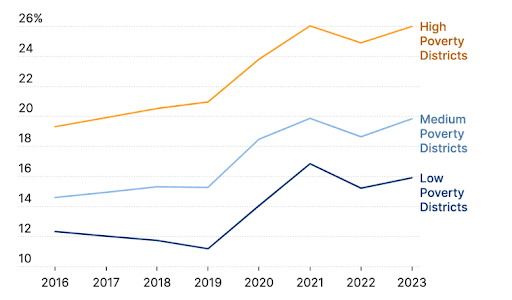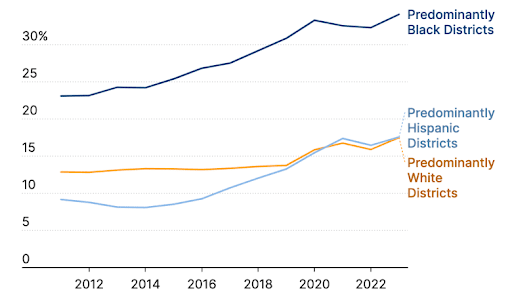Resource: Brookings, “Decreasing public institution enrollment,” August 2025
Independent school registration flat
Before the pandemic, the share of pupils in traditional public institutions held steady, floating near 85 percent in between 2016 and 2020 After the pandemic, standard public college registration plummeted to listed below 80 percent and hasn’t recoiled.
The mysterious missing children represent a huge chunk of the decrease. But households also changed to charter and online colleges. Charter institution registration increased from 5 percent of students in 2016 – 17 to 6 percent in 2023 – 24 The number of children going to online schools almost doubled from 0. 7 percent before the pandemic in 2019 – 20 to 1 2 percent in 2020 – 21 and has remained raised.
Remarkably, private school enrollment has remained stable at nearly 9 percent of school-age children in between 2016 – 17 and 2023 – 24, according to this Brookings estimate.
I had expected independent school registration to increase, as family members soured on public college disturbances during the pandemic, and as 11 states, including Arizona and Florida, released their own academic interest-bearing account or new voucher programs to aid pay the tuition. However another evaluation , released this month by researchers at Tulane University, resembled the Brookings numbers. It located that private school enrollments had raised by just 3 to 4 percent between 2021 and 2024, compared to states without vouchers. A brand-new federal tax credit to fund independent school scholarships is still more than a year away from going into impact on Jan. 1, 2027, and perhaps a higher shift right into personal education and learning is still ahead.
Defections from traditional public institutions are largest in Black and high-poverty districts
I would certainly have presumed that wealthier families that can manage private school tuition would be most likely to look for choices. However high-poverty areas had the biggest share of students outside the traditional public-school field. In addition to independent school, they were enrolled in charters, virtual colleges, specialized schools for trainees with impairments or various other alternative colleges, or were homeschooling.
Greater than 1 in 4 students in high-poverty districts aren’t registered in a conventional public school, compared with 1 in 6 pupils in low-poverty college districts. The steepest public school registration losses are concentrated in primarily Black college districts. A third of pupils in mainly Black areas are not in traditional public institutions, double the share of white and Hispanic pupils.
Share of pupil registration beyond typical public institutions, by area destitution

Resource: Brookings, “Declining public school enrollment,” August 2025
Share of students not enrolled in traditional public institutions by race and ethnic background

Resource: Brookings, “Decreasing public institution registration,” August 2025
These inconsistencies matter for the students who continue to be in standard public institutions. Schools in low-income and Black communities are currently shedding one of the most trainees, forcing even steeper budget plan cuts.
The group timebomb
Before the pandemic, U.S. schools were already gone to a big contraction. The typical American female is now giving birth to just 1 7 kids over her life time, well listed below the 2 1 fertility rate required to change the population. Fertility rates are forecasted to drop further still. The Brookings experts presume even more immigrants will certainly remain to go into the country, in spite of current migration limitations, however insufficient to balance out the decline in births.
Even if families go back to their pre-pandemic enrollment patterns, the populace decrease would imply 2 2 million fewer public college students by 2050 However if parents keep selecting other kinds of colleges at the rate observed given that 2020, conventional public colleges could shed as many as 8 5 million students, shrinking from 43 06 million in 2023 – 24 to as couple of as 34 57 million by mid-century.
Between students gone missing, the choices some Black households and households in high-poverty areas are making and the number of children are being birthed, the general public institution landscape is shifting. Distort up and get ready for mass public institution closures
This tale regarding school registration declines was generated by The Hechinger Record , a nonprofit, independent news organization concentrated on inequality and technology in education. Sign up for Proof Points and other Hechinger e-newsletters